Day 15, April 21: Hontanas to Castrojeriz (11.5 km, 7.2 miles)
The final vestiges of daylight are lingering (but not for long; it is 9:27) on Wednesday as I attempt to go back in time and do the promised write-up for Easter Sunday. Because four of my five roommates have settled into their sleeping bags and the fifth is reading with a backlit Kindle, I have turned off the lights in this room and am lighting my keyboard with the headlamp I’ve put around my neck. (Have I told you that sometimes I sleep with it there? It’s the best way to not lose it at night, especially when I’m on a top bunk with no shelf attached to it. Wish I had as easy a solution for my glasses….) But let’s see if I can’t write this up and actually be caught up. Not that I’m obsessed with this project, but it will feel good to be up-to-date. And, this too: Amy has been asking me for weeks where I would celebrate Easter. She wanted the “Easter story” and I want the memories before they fade. And so I continue.)
Hontanas didn’t necessarily roll up its sidewalks early on Saturday evening, but the folks in my albergue certainly did. By the time I returned home from dinner down the street and brought in my laundry, the room was dark. Ditto when my alarm went off in the morning. What? Is that all these people do? Sleep? I dressed silently, my clothes generally at the foot of the bed where, if I’m lucky, I don’t kick them off (as in “down”) during the night, and then slipped out to the kitchen/common area. It was about 6:30. A few pilgrims were in there already, doing their final pack loading by the light in the kitchen so as not to wake their bunkmates. Me? I arrived not with my pack but with my keyboard. I was going to work on the Saturday post until such time as I thought the lights would be on in my room (I can type by flashlight but have no desire to pack my bag with that kind of a focused beam). I was soon on a roll with the writing. Only to remember that at this albergue we left our shoes outside in a covered portion of the patio. I slipped out, stockinged feet, to bring them inside to warm up.
Now what one often hears about is Easter sunrise, I know. But the full moon (“officially” full? I couldn’t say, but big, bright) caught my attention as much as any sunrise might. It’s Easter! The light shines! Hope resumes. Life goes on. Brrr it’s cold out here! Back in I go with the reclaimed shoes. Back to the keyboard.
But then… we were supposed to be out of the rooms by 8:00, so I returned to the room to pack up. Then headed for the hostel’s reception room/breakfast corner. “Yes,” the innkeeper told me, “you can stay here as long as you like. It’s just the dormitories that need to be vacated.” A few pilgrims were in this lobby area trying to figure out how to move forward and wait out their injuries. Others, early risers who had spent the night in a town or two short of Hontanas, began to arrive. Coffee, pastries, tortillas de patatas were served up. I, of course, resumed my narration of the day before, sharing my table and a word here and there with… Grace. I believe it was Grace. (Did I tell you that I met up with–again–both Grace and Kelly in Hontanas, Kelly at a different hostel just down the street. Kind of fun, the Grace & Kelly coincidence…)
It was nice to be relaxed. Having walked an extra long day on Saturday, I had just a bit over 7 miles to cover to arrive in Castrojeriz and meet up wit Ginny. I had alerted her to the existence of a 1:00 mass in Castrojeriz and to the likelihood that I would go straight to the church rather then check in first at the albergue. I calculated the time and felt that if I left Hontanas shortly after 10:00, I would have more than enough time. (I don’t want to keep you on the edge of your seats; relax: I had calculated correctly and did have enough time.)
I set off, finally, trying to focus on Easter. It was a pleasant enough day by mid-morning. Not warm, but pleasant enough. Time to sing some Alleluias. I have a whole collection of songs on my iPod that contain the word, some specifically meant for Easter, some with a more coincidental, general use of the word. Did I want to dig out my headphones? I know where they are, but I haven’t used them yet and kind of like it that way. Do I manage to summon up many of the songs? Not really. Melodies, yes, but pretty weak on the words. Isn’t it the thought that counts?
Chiming right along with me? The darn cuckoo bird. “Cuckoo! Cuckoo! Cuckoo!” Over and over. Yes, I know that rising from the dead is pretty preposterous. Yes, of course, it defies reason. It defies nature. And logic. But isn’t that what makes it so wondrous, so astonishing, so worth celebrating? I continue with my alleluias, the cuckoo with its taunt. I didn’t let it shake my mood. I’m celebrating.
I hear a clanking sound. Look around for a lone sheep or cow, the bell around its neck giving a slight vibration. No, it’s the conch shell most pilgrims have fastened to their packs. Mine is clanging against the carabiner-style S hook which sometimes holds one or the other of my jackets. I move on. No animals to photograph this morning.
And then I’m in town–Castrojeriz– studying the map conveniently placed at the entrance to the village, trying to figure out where our hostel is and where the church of San Juan is. The latter, all the way at the other end of the village. Now at the entrance of the town, I continue up the hill towards the center and beyond. Another sound. Drums. Drums? Drums! A procession!
I ask you: what are the chances? I had missed the big processions in Burgos on Holy Thursday and Good Friday. I knew they were going to take place, that they would draw a crowd, just as I knew that the interior of the cathedral would be spectacular, but… I just couldn’t cover all the territory. And now? Now I am getting a chance to witness a procession I didn’t even know would be taking place, and I had arrived with just enough time to dig out my camera and catch a video. A short video. Because here’s the thing: Castrojeriz is a town of 500 souls, half of whom may well travel elsewhere for the holiday. This, however, is what Ilove. The small-town celebration of tradition and faith and culture and custom.
So what all is involved in this tiny procession? Well, a grand total of three floats, one of Jesus, one of Mary…. and…. the third one was pretty small, another Mary I think. There were not huge pasos, not many men required to carry them. There were the flag bearer, two big flags, I think. the priest, the altar girl, a choir consisting of four women who were singing their hearts out, and then the faithful. Or at least the abler-bodied among the faithful. 20, 25 people maybe. I went up to two women at the tail end. “Perdón, señoras, ¿va lejos la procesión?” I asked them. Does it go far? “Well, far enough,” they told me. I considered. I had just trudged up the hill, halfway through the village. I learned that this procession would go down the way I had come, back to the entrance into town, then make a loop that would bring it back to the church of San Juan where I was heading, arriving in time for the 1:00 pm mass.
No, I didn’t have it in me to retrace my steps. I would meet the procession at the church. And Ginny, too, to whom I texted, letting her know that I had arrived and was going to have a bite to eat on the wall in front of the church. If she wanted to see the procession, then hurry on over. She soon joined me and she nibbled at some of my cheese while I ate a good chunk of it as well as an orange and a tomato, leaning over so as not to stain my Easter finery (that is, the same clothes I have worn since April 2!). Meanwhile, one by one those not able to join the actual procession began arriving in the plaza in front of the church, awaiting the procession’s return. We–Ginny and I–attracted a fair bit of attention. First there was the man with a cape. A priest, Ginny thought. But no, it was a cofrade–let’s say something like a Knight of Columbus or a member of the Moose or the Legion–only in this case, someone, as he told us, responsible for setting up the Holy Week processions and making sure that they run smoothly. Proud of his position, for sure. Others came round to speak with us, as if we were curiosity pieces. As far as I could tell, we were the only pilgrims involved in this event, though I might be wrong.
And then the drums, the return of the procession. Either the pace had picked up a bit or I was seeing the procession from a different angle, but here’s what I noticed: as the carriers held on to the handles on the side of the platform on which Jesus stood, his raised right arms jiggled back and forth, as if he were a celebrity waving at the crowd. (Well, after all, wasn’t he?) I found it both comical and sweet. Jesus needed more than the loin cloth that was wrapped around him; it was nippy.
So nippy, in fact, that I also noticed that no one in the congregation was intent on being seen in his or her Easter finery. All were in winter coats, mostly dark in color. They were dressed for the weather. My kind of people! A few minutes into the mass which had started as soon as the three statues were situated at the front of the church, I whispered to Ginny (she was seated in front of me so that we both had an unobstructed view of the altar in spite of the many columns in the church), “Did you notice the altar girl?” “Yes,” she nodded with a grin. The poor little thing: there she was in her cassock with the fur-lined hood of her winter coat sticking up and out. Man, those old churches are cold. And what kind of a fortune would it take to heat them? One that these villages certainly don’t have.
The acoustic system, however, was very modern, and the priest was another one of those real “shepherds.” This was the second church of San Juan in which I had participated in a mass here in Spain, and the only churches where I could both hear and understand the priests, both of whom were full of smiles for their flock (in the case of the other San Juan church, the flock had consisted strictly of pilgrims), spoke powerful messages (I expected applause, bravos, or alleluias at the end of this homily, that’s how good it was IMHO, but there were none), and had a flair for oratory, parallel constructions, dramatic pauses, rhetorical questions, etc. I ate it up and remembered why I always like the Spanish language so much. Like many priests at an Easter service, he remarked on how nice it would be to have such a full house every Sunday and, with a twinkle in his eye, said he’d look forward to seeing them all the next week.
Ginny went over to light a candle at a side altar (have I mentioned that almost without exception the candles in the churches I’ve been to are all battery-operated? Put in half a euro and five or more candles are likely to light up… except when they don’t…). On her way, she was briefly intercepted by a 55 or 60-ish lady who had been sitting close to us. Ginny went on to the candles and the woman turned to me. “She was crying, your friend,” she told me. “You know,” she continued, I’ve been a pilgrim, too. Three times I’ve done the Camino. It brings out the emotions in people.” Yes, indeed!
So there, in a bit more than a nutshell, was my Easter. Loved being in the small-town atmosphere, having some interaction with the locals. It felt right. I was glad I hadn’t thought too long or too hard about where I would be, hadn’t looked for a showy, splashy atmosphere. This was perfect.
A few more things I remember about the day:
- The cofrade was eager to share with us that Castrojeriz was, at 2 kilometers, the longest pueblo [“small town”] on the entire Camino
- Ginny had an Easter gift for me. You remember the bar where we ate almost all our meals in Burgos? Right across from the albergue municipal? Ginny had noticed a single teal hiking pole, identical to mine, just sitting in a corner there, day after day. Until, it wasn’t, because Ginny picked it up to pass along to me. (You may recall that one of mine broke and we found an unclaimed red one that we appropriated.) Now, once again, I have matching poles. We left the red one in Castrojeriz for the next “lame” pilgrim. Once again, the Camino provided. Twice with poles.
- We loved the Albergue Rosalía and spent a good bit of the afternoon hanging in the “honest kitchen” (use what you need, drop some coins in the box to help pay for staples), half listening to various conversations, half attempting to communicate with family, plan Ginny’s next move, do some blog updating. That evening there was a lovely communal dinner for those who wanted it (and wanted to pay the going price which, for most of our full, pilgrim-priced dinners, is 10 euros). I think that was the night with the two chicken legs, the vegetable “pasta paella,” a nice salad with home-made hummus to go with the fresh bread, and a go-down-smooth-and-easy “chocolate heaven” dessert. We were Americans, Australians, Germans, French, Austrians… learning a bit about one another’s spouses, children, reasons for doing the Camino. Nice.
I wasn’t eavesdropping, but whether one knew French or not, the tone was clear (ask Ginny, who knows no French): the icing on the cake this Easter Sunday evening was being present as a pilgrim from France was talking to his family at home, “tucking” in his 8 and 10-year-olds, saying goodnight to his wife. Such sweet tones. He explained, afterwards, that he is accompanying his father on this trip, that he didn’t want to leave his family but that his wife, who had recently lost both parents, told him that he should go, that he might not have many more opportunities to do something this special with his father. The first week, he said, he couldn’t bear to call home, he missed his family so much. It has become easier now. Early on, it broke his heart; now, now he can bear it.
The Camino at work.
Easter at work.
It was a good day.
Alleluia. Go fly a kite, cuckoo bird!
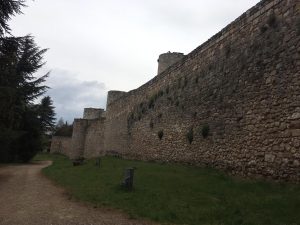
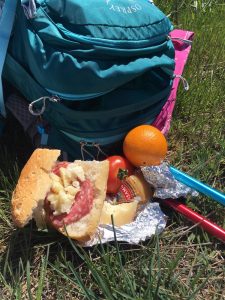
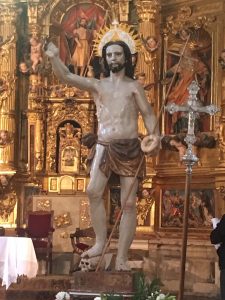

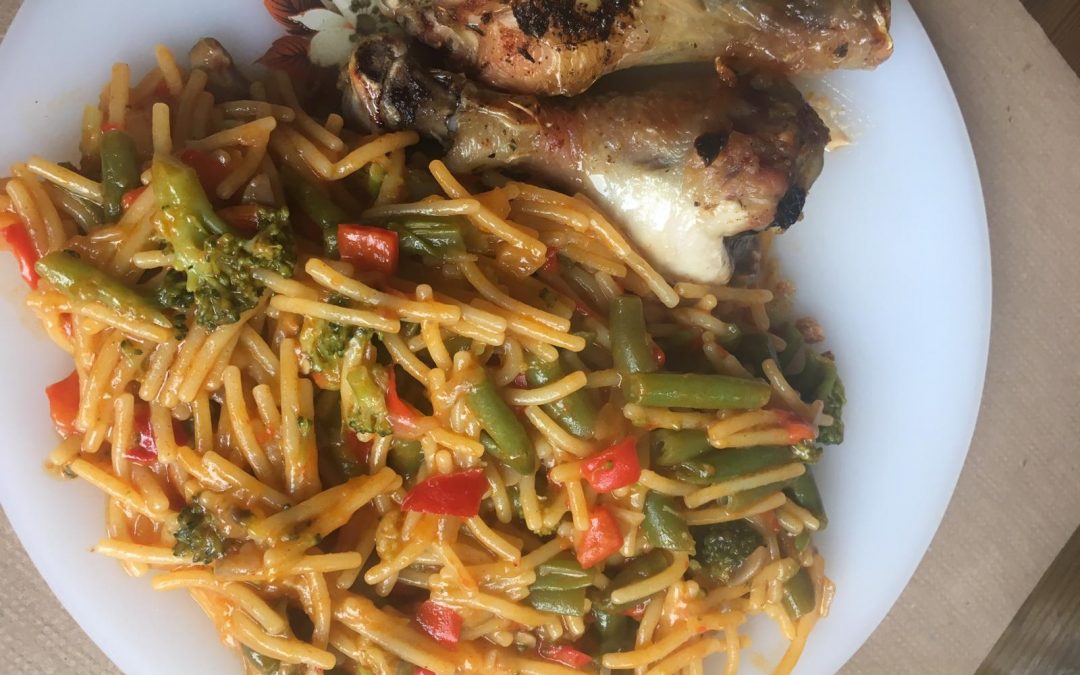
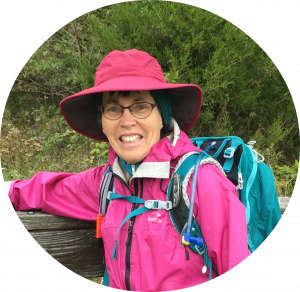
Wow! What an adventure!😊❤
So lovely. perfect. Very good camino stories.
Love the photos! Even tho, I’m not religious, I always liked the pomp and ceremony and processions of Semana Santa in Spain. It all just seems to draw you in. Also, I marvel at how many people are braving the unpredictable spring weather to join you on this journey – I expect it is life-changing as your fellow travelers have said.
I liked the story of the man who missed his children and wife while he walked the Camino with his aging father. Later, he will be happy he spent this time with his father, long into his own old age, should he be so lucky as to live a long life. Another bittersweet moment was your brief moment talking with the woman who spotted Ginny with tears going down her cheeks as she walked away from lighting candles (lights). I sure hope Ginny is okay. I know you’re taking good care of her, although knowing Ginny, she’s pretty good at taking care of herself no matter what the conditions. Well, you’re probably sound asleep as I write this; I wish you pleasant dreams, Katy dear, and a good beginning for tomorrow.